A Comparative Study of BRIC Nations: Tech & Environment Policies
VerifiedAdded on 2019/12/18
|44
|14764
|50
Dissertation
AI Summary
This dissertation presents a comparative analysis of the BRIC countries (Brazil, Russia, India, and China), focusing on their technological advancements and the corresponding environmental policies. The study explores the economic and demographic characteristics of these nations, recognizing their significant role in global trade and development. The research investigates the pros and cons of technological progress in these countries, particularly its impact on natural resources. The methodology includes an interpretivism philosophy and the use of secondary data, incorporating business models such as SWOT and PESTLE analyses for each country. The findings reveal the high levels of technological development in all four nations and its associated environmental damage. The dissertation concludes with recommendations for adopting environmentally friendly practices and policies to mitigate the negative impacts of technological advancement. The structure includes an introduction, literature review, research methodologies, data analysis, and conclusions with recommendations, providing a comprehensive overview of the subject.
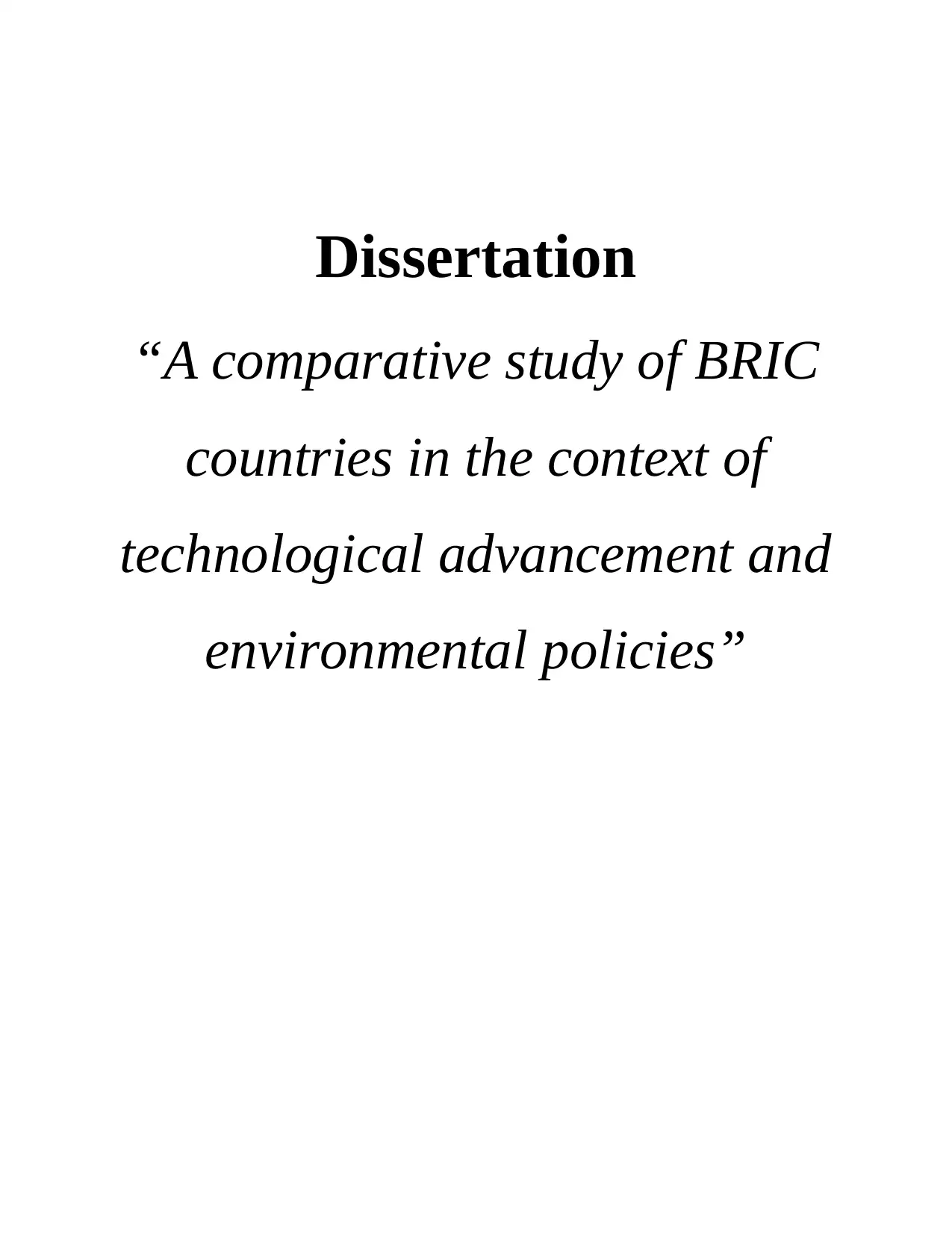
Dissertation
“A comparative study of BRIC
countries in the context of
technological advancement and
environmental policies”
“A comparative study of BRIC
countries in the context of
technological advancement and
environmental policies”
Paraphrase This Document
Need a fresh take? Get an instant paraphrase of this document with our AI Paraphraser

ACKNOWLEDGEMENT
I am so thankful to all those persons who have given me provision, guidance as well as
much needed motivation so as to complete the current research study. Firstly, I owe my thanks to
guide who gave me chance to undertake this dissertation. Furthermore, I am thankful to my team
members, family and friends who helped me in all possible accords. This led to a successful
completion of my dissertation and achievement of relevant results.
I am so thankful to all those persons who have given me provision, guidance as well as
much needed motivation so as to complete the current research study. Firstly, I owe my thanks to
guide who gave me chance to undertake this dissertation. Furthermore, I am thankful to my team
members, family and friends who helped me in all possible accords. This led to a successful
completion of my dissertation and achievement of relevant results.
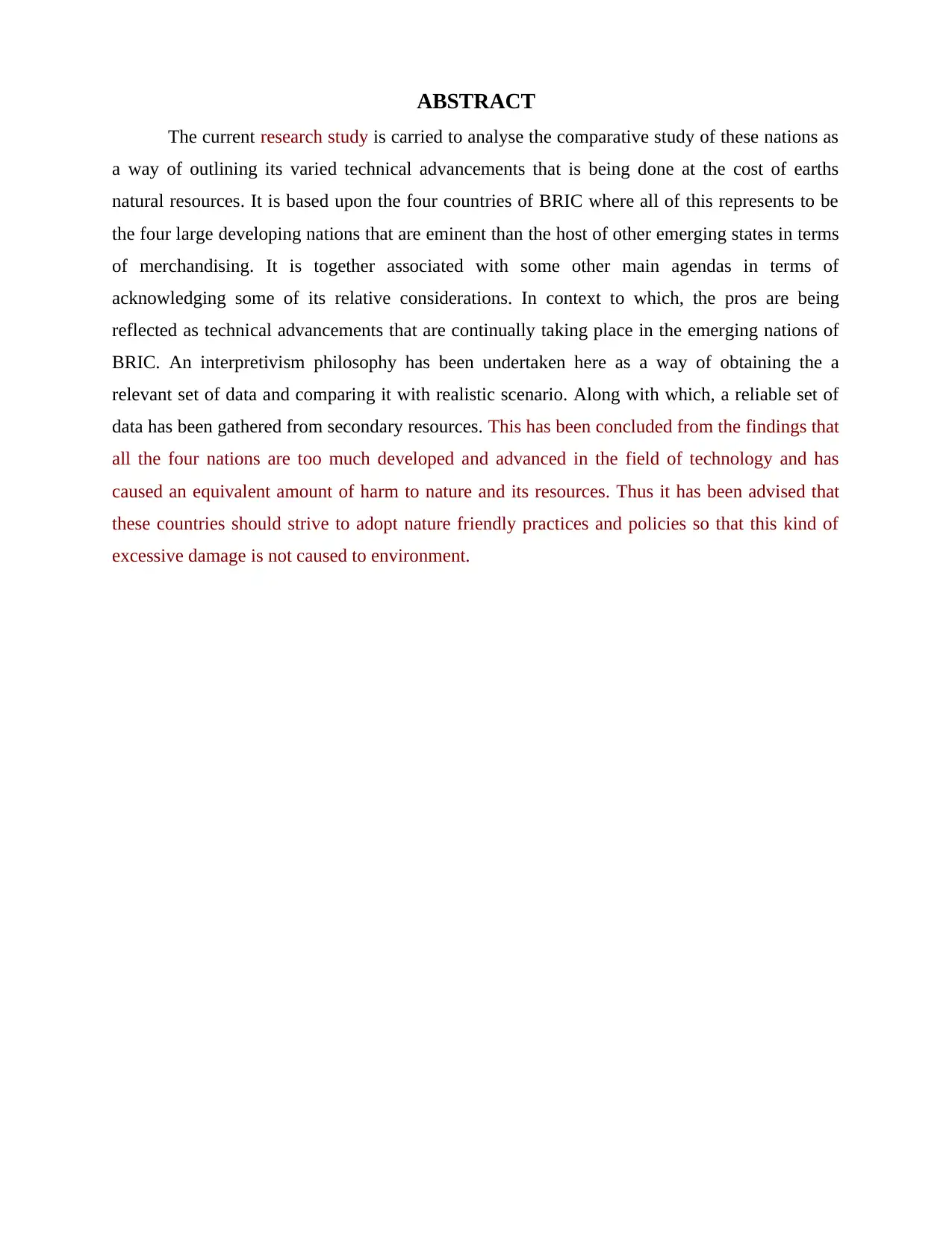
ABSTRACT
The current research study is carried to analyse the comparative study of these nations as
a way of outlining its varied technical advancements that is being done at the cost of earths
natural resources. It is based upon the four countries of BRIC where all of this represents to be
the four large developing nations that are eminent than the host of other emerging states in terms
of merchandising. It is together associated with some other main agendas in terms of
acknowledging some of its relative considerations. In context to which, the pros are being
reflected as technical advancements that are continually taking place in the emerging nations of
BRIC. An interpretivism philosophy has been undertaken here as a way of obtaining the a
relevant set of data and comparing it with realistic scenario. Along with which, a reliable set of
data has been gathered from secondary resources. This has been concluded from the findings that
all the four nations are too much developed and advanced in the field of technology and has
caused an equivalent amount of harm to nature and its resources. Thus it has been advised that
these countries should strive to adopt nature friendly practices and policies so that this kind of
excessive damage is not caused to environment.
The current research study is carried to analyse the comparative study of these nations as
a way of outlining its varied technical advancements that is being done at the cost of earths
natural resources. It is based upon the four countries of BRIC where all of this represents to be
the four large developing nations that are eminent than the host of other emerging states in terms
of merchandising. It is together associated with some other main agendas in terms of
acknowledging some of its relative considerations. In context to which, the pros are being
reflected as technical advancements that are continually taking place in the emerging nations of
BRIC. An interpretivism philosophy has been undertaken here as a way of obtaining the a
relevant set of data and comparing it with realistic scenario. Along with which, a reliable set of
data has been gathered from secondary resources. This has been concluded from the findings that
all the four nations are too much developed and advanced in the field of technology and has
caused an equivalent amount of harm to nature and its resources. Thus it has been advised that
these countries should strive to adopt nature friendly practices and policies so that this kind of
excessive damage is not caused to environment.
⊘ This is a preview!⊘
Do you want full access?
Subscribe today to unlock all pages.

Trusted by 1+ million students worldwide
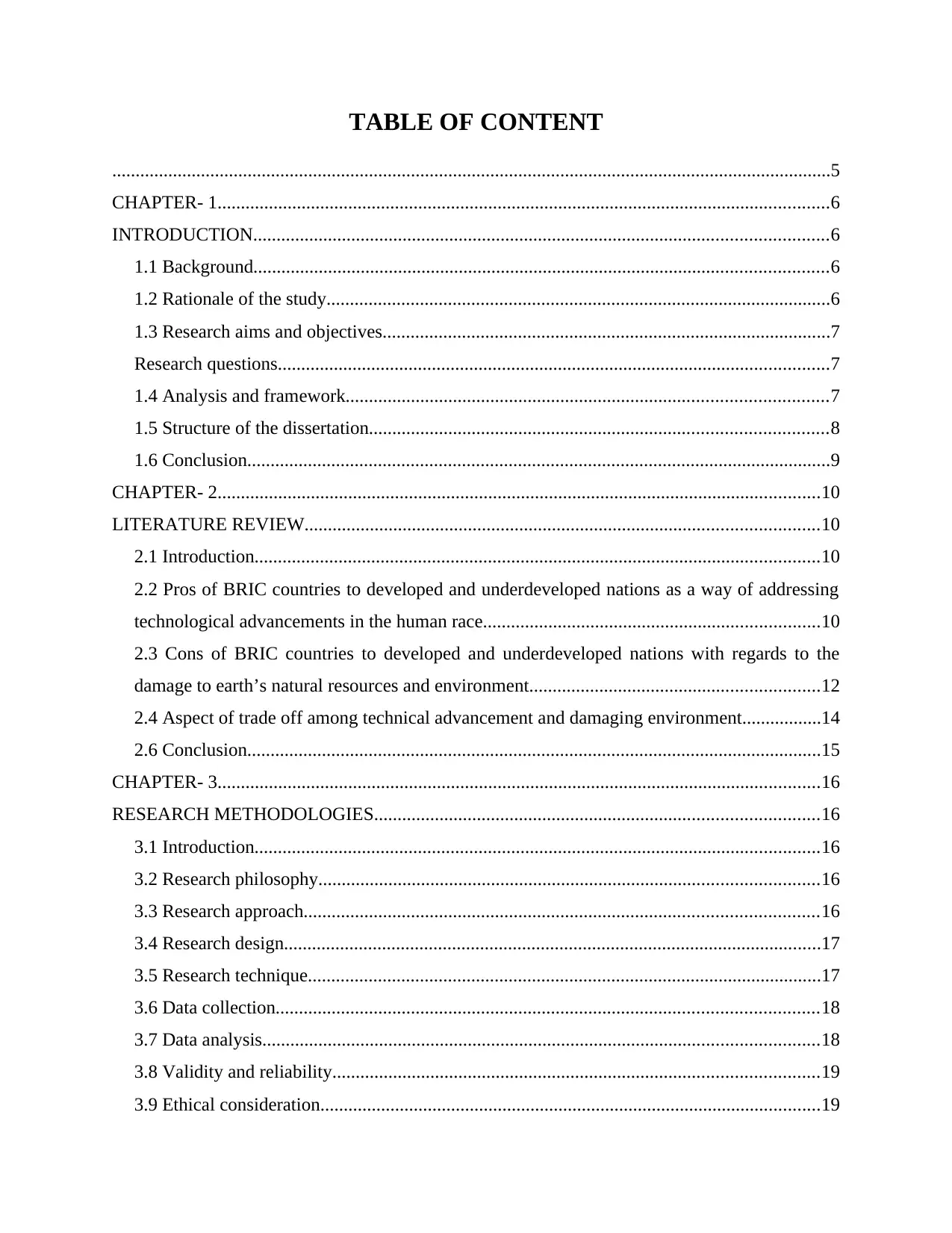
TABLE OF CONTENT
..........................................................................................................................................................5
CHAPTER- 1...................................................................................................................................6
INTRODUCTION...........................................................................................................................6
1.1 Background...........................................................................................................................6
1.2 Rationale of the study............................................................................................................6
1.3 Research aims and objectives................................................................................................7
Research questions......................................................................................................................7
1.4 Analysis and framework.......................................................................................................7
1.5 Structure of the dissertation..................................................................................................8
1.6 Conclusion.............................................................................................................................9
CHAPTER- 2.................................................................................................................................10
LITERATURE REVIEW..............................................................................................................10
2.1 Introduction.........................................................................................................................10
2.2 Pros of BRIC countries to developed and underdeveloped nations as a way of addressing
technological advancements in the human race........................................................................10
2.3 Cons of BRIC countries to developed and underdeveloped nations with regards to the
damage to earth’s natural resources and environment..............................................................12
2.4 Aspect of trade off among technical advancement and damaging environment.................14
2.6 Conclusion...........................................................................................................................15
CHAPTER- 3.................................................................................................................................16
RESEARCH METHODOLOGIES...............................................................................................16
3.1 Introduction.........................................................................................................................16
3.2 Research philosophy...........................................................................................................16
3.3 Research approach..............................................................................................................16
3.4 Research design...................................................................................................................17
3.5 Research technique..............................................................................................................17
3.6 Data collection....................................................................................................................18
3.7 Data analysis.......................................................................................................................18
3.8 Validity and reliability........................................................................................................19
3.9 Ethical consideration...........................................................................................................19
..........................................................................................................................................................5
CHAPTER- 1...................................................................................................................................6
INTRODUCTION...........................................................................................................................6
1.1 Background...........................................................................................................................6
1.2 Rationale of the study............................................................................................................6
1.3 Research aims and objectives................................................................................................7
Research questions......................................................................................................................7
1.4 Analysis and framework.......................................................................................................7
1.5 Structure of the dissertation..................................................................................................8
1.6 Conclusion.............................................................................................................................9
CHAPTER- 2.................................................................................................................................10
LITERATURE REVIEW..............................................................................................................10
2.1 Introduction.........................................................................................................................10
2.2 Pros of BRIC countries to developed and underdeveloped nations as a way of addressing
technological advancements in the human race........................................................................10
2.3 Cons of BRIC countries to developed and underdeveloped nations with regards to the
damage to earth’s natural resources and environment..............................................................12
2.4 Aspect of trade off among technical advancement and damaging environment.................14
2.6 Conclusion...........................................................................................................................15
CHAPTER- 3.................................................................................................................................16
RESEARCH METHODOLOGIES...............................................................................................16
3.1 Introduction.........................................................................................................................16
3.2 Research philosophy...........................................................................................................16
3.3 Research approach..............................................................................................................16
3.4 Research design...................................................................................................................17
3.5 Research technique..............................................................................................................17
3.6 Data collection....................................................................................................................18
3.7 Data analysis.......................................................................................................................18
3.8 Validity and reliability........................................................................................................19
3.9 Ethical consideration...........................................................................................................19
Paraphrase This Document
Need a fresh take? Get an instant paraphrase of this document with our AI Paraphraser
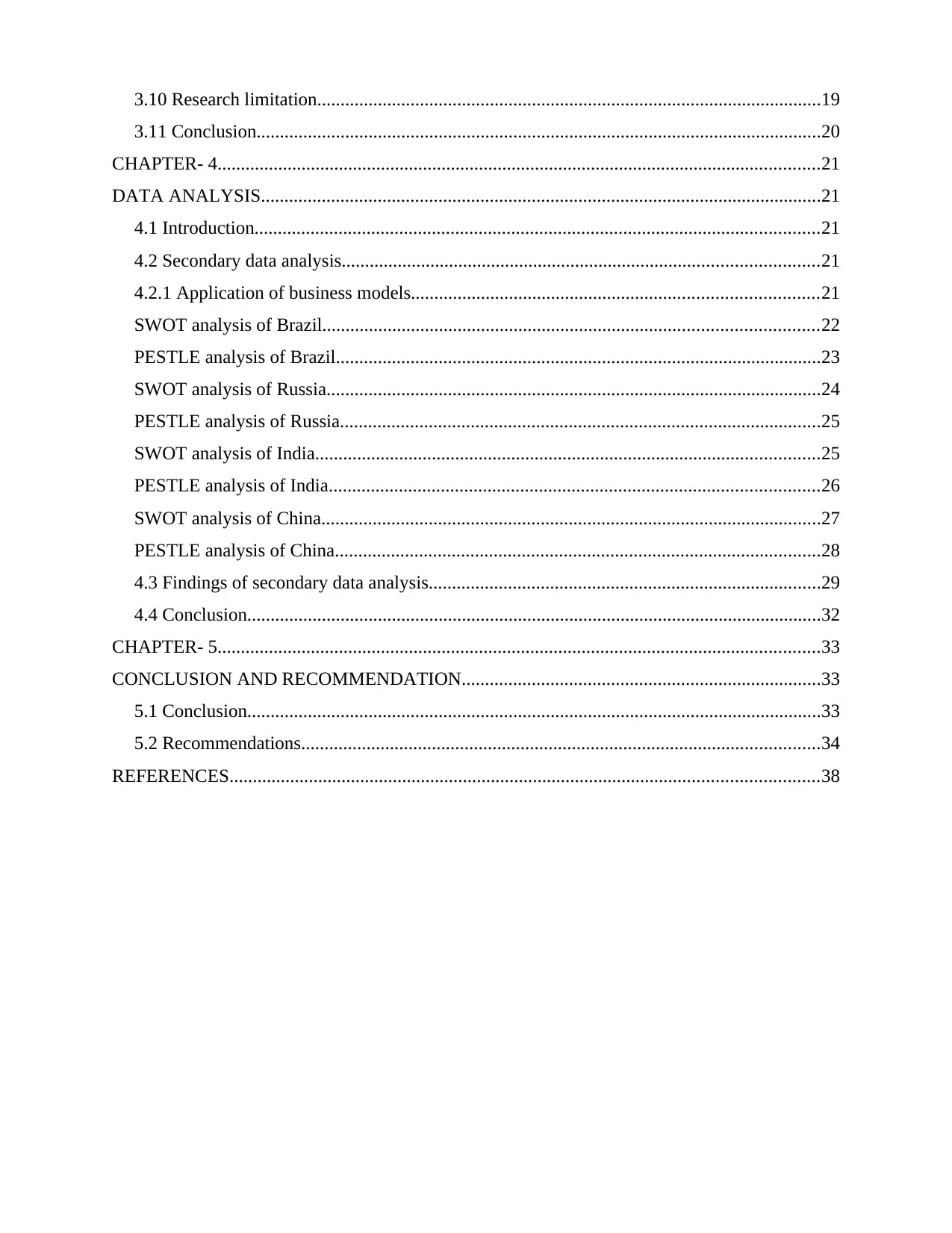
3.10 Research limitation............................................................................................................19
3.11 Conclusion.........................................................................................................................20
CHAPTER- 4.................................................................................................................................21
DATA ANALYSIS........................................................................................................................21
4.1 Introduction.........................................................................................................................21
4.2 Secondary data analysis......................................................................................................21
4.2.1 Application of business models.......................................................................................21
SWOT analysis of Brazil..........................................................................................................22
PESTLE analysis of Brazil........................................................................................................23
SWOT analysis of Russia..........................................................................................................24
PESTLE analysis of Russia.......................................................................................................25
SWOT analysis of India............................................................................................................25
PESTLE analysis of India.........................................................................................................26
SWOT analysis of China...........................................................................................................27
PESTLE analysis of China........................................................................................................28
4.3 Findings of secondary data analysis....................................................................................29
4.4 Conclusion...........................................................................................................................32
CHAPTER- 5.................................................................................................................................33
CONCLUSION AND RECOMMENDATION.............................................................................33
5.1 Conclusion...........................................................................................................................33
5.2 Recommendations...............................................................................................................34
REFERENCES..............................................................................................................................38
3.11 Conclusion.........................................................................................................................20
CHAPTER- 4.................................................................................................................................21
DATA ANALYSIS........................................................................................................................21
4.1 Introduction.........................................................................................................................21
4.2 Secondary data analysis......................................................................................................21
4.2.1 Application of business models.......................................................................................21
SWOT analysis of Brazil..........................................................................................................22
PESTLE analysis of Brazil........................................................................................................23
SWOT analysis of Russia..........................................................................................................24
PESTLE analysis of Russia.......................................................................................................25
SWOT analysis of India............................................................................................................25
PESTLE analysis of India.........................................................................................................26
SWOT analysis of China...........................................................................................................27
PESTLE analysis of China........................................................................................................28
4.3 Findings of secondary data analysis....................................................................................29
4.4 Conclusion...........................................................................................................................32
CHAPTER- 5.................................................................................................................................33
CONCLUSION AND RECOMMENDATION.............................................................................33
5.1 Conclusion...........................................................................................................................33
5.2 Recommendations...............................................................................................................34
REFERENCES..............................................................................................................................38
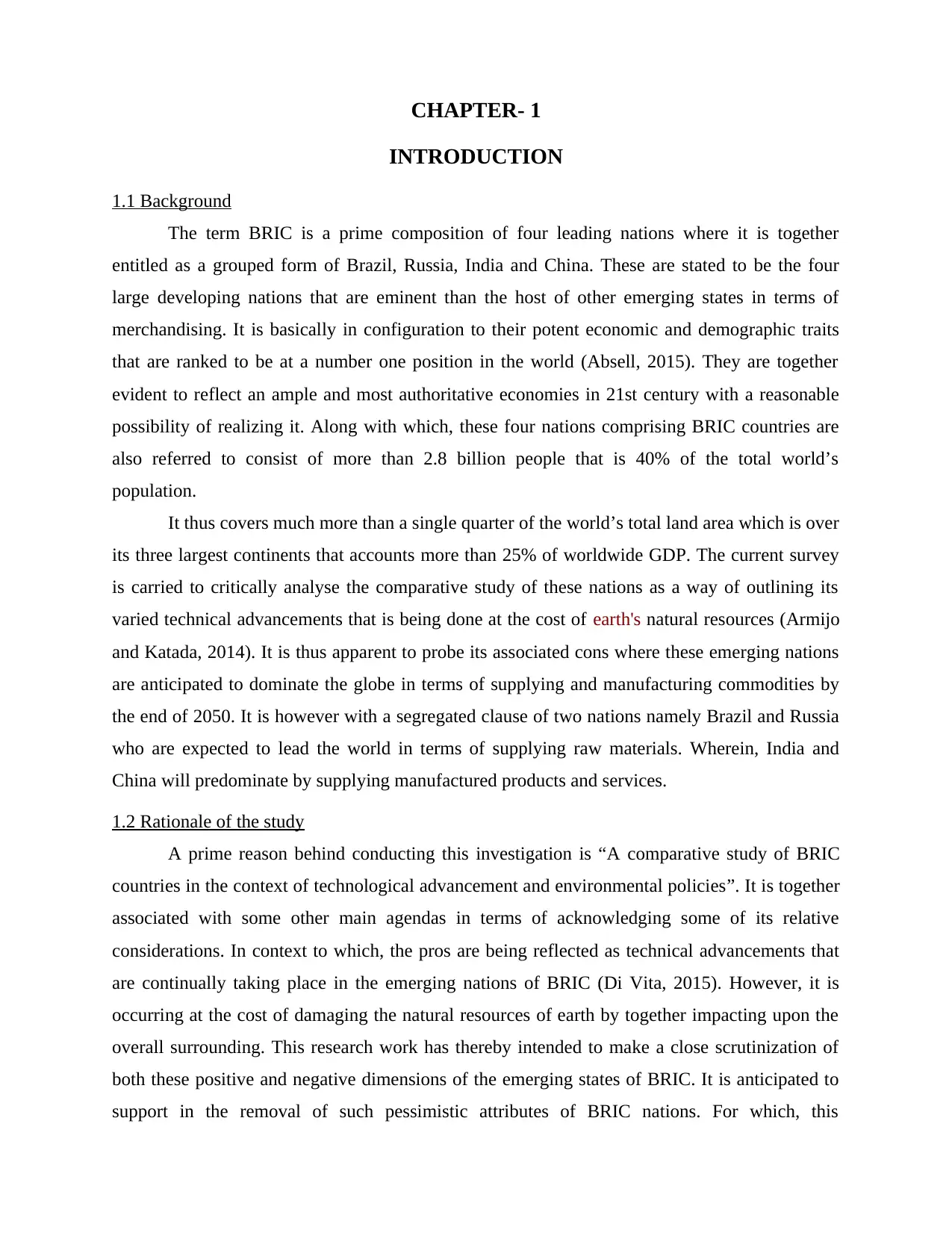
CHAPTER- 1
INTRODUCTION
1.1 Background
The term BRIC is a prime composition of four leading nations where it is together
entitled as a grouped form of Brazil, Russia, India and China. These are stated to be the four
large developing nations that are eminent than the host of other emerging states in terms of
merchandising. It is basically in configuration to their potent economic and demographic traits
that are ranked to be at a number one position in the world (Absell, 2015). They are together
evident to reflect an ample and most authoritative economies in 21st century with a reasonable
possibility of realizing it. Along with which, these four nations comprising BRIC countries are
also referred to consist of more than 2.8 billion people that is 40% of the total world’s
population.
It thus covers much more than a single quarter of the world’s total land area which is over
its three largest continents that accounts more than 25% of worldwide GDP. The current survey
is carried to critically analyse the comparative study of these nations as a way of outlining its
varied technical advancements that is being done at the cost of earth's natural resources (Armijo
and Katada, 2014). It is thus apparent to probe its associated cons where these emerging nations
are anticipated to dominate the globe in terms of supplying and manufacturing commodities by
the end of 2050. It is however with a segregated clause of two nations namely Brazil and Russia
who are expected to lead the world in terms of supplying raw materials. Wherein, India and
China will predominate by supplying manufactured products and services.
1.2 Rationale of the study
A prime reason behind conducting this investigation is “A comparative study of BRIC
countries in the context of technological advancement and environmental policies”. It is together
associated with some other main agendas in terms of acknowledging some of its relative
considerations. In context to which, the pros are being reflected as technical advancements that
are continually taking place in the emerging nations of BRIC (Di Vita, 2015). However, it is
occurring at the cost of damaging the natural resources of earth by together impacting upon the
overall surrounding. This research work has thereby intended to make a close scrutinization of
both these positive and negative dimensions of the emerging states of BRIC. It is anticipated to
support in the removal of such pessimistic attributes of BRIC nations. For which, this
INTRODUCTION
1.1 Background
The term BRIC is a prime composition of four leading nations where it is together
entitled as a grouped form of Brazil, Russia, India and China. These are stated to be the four
large developing nations that are eminent than the host of other emerging states in terms of
merchandising. It is basically in configuration to their potent economic and demographic traits
that are ranked to be at a number one position in the world (Absell, 2015). They are together
evident to reflect an ample and most authoritative economies in 21st century with a reasonable
possibility of realizing it. Along with which, these four nations comprising BRIC countries are
also referred to consist of more than 2.8 billion people that is 40% of the total world’s
population.
It thus covers much more than a single quarter of the world’s total land area which is over
its three largest continents that accounts more than 25% of worldwide GDP. The current survey
is carried to critically analyse the comparative study of these nations as a way of outlining its
varied technical advancements that is being done at the cost of earth's natural resources (Armijo
and Katada, 2014). It is thus apparent to probe its associated cons where these emerging nations
are anticipated to dominate the globe in terms of supplying and manufacturing commodities by
the end of 2050. It is however with a segregated clause of two nations namely Brazil and Russia
who are expected to lead the world in terms of supplying raw materials. Wherein, India and
China will predominate by supplying manufactured products and services.
1.2 Rationale of the study
A prime reason behind conducting this investigation is “A comparative study of BRIC
countries in the context of technological advancement and environmental policies”. It is together
associated with some other main agendas in terms of acknowledging some of its relative
considerations. In context to which, the pros are being reflected as technical advancements that
are continually taking place in the emerging nations of BRIC (Di Vita, 2015). However, it is
occurring at the cost of damaging the natural resources of earth by together impacting upon the
overall surrounding. This research work has thereby intended to make a close scrutinization of
both these positive and negative dimensions of the emerging states of BRIC. It is anticipated to
support in the removal of such pessimistic attributes of BRIC nations. For which, this
⊘ This is a preview!⊘
Do you want full access?
Subscribe today to unlock all pages.

Trusted by 1+ million students worldwide
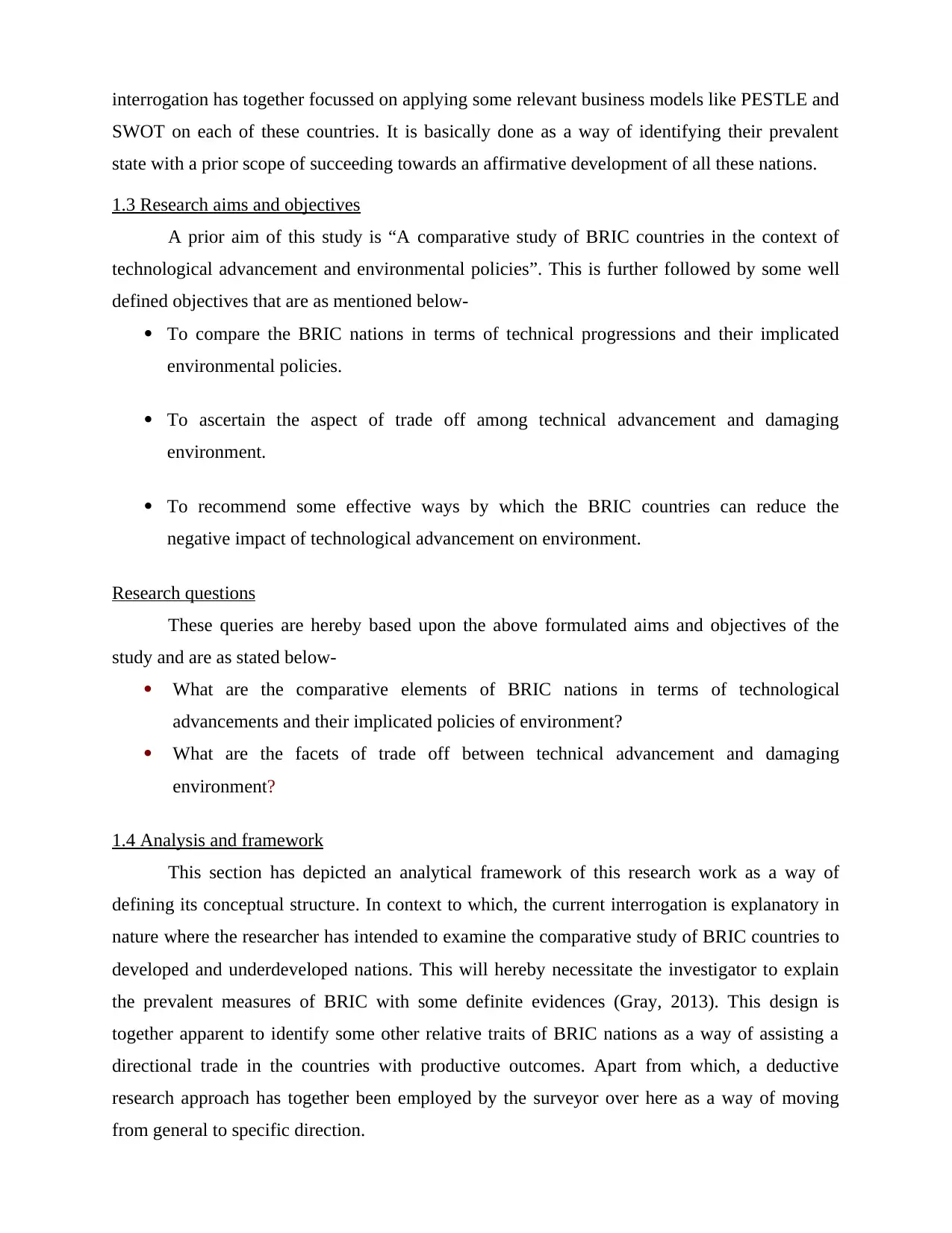
interrogation has together focussed on applying some relevant business models like PESTLE and
SWOT on each of these countries. It is basically done as a way of identifying their prevalent
state with a prior scope of succeeding towards an affirmative development of all these nations.
1.3 Research aims and objectives
A prior aim of this study is “A comparative study of BRIC countries in the context of
technological advancement and environmental policies”. This is further followed by some well
defined objectives that are as mentioned below-
To compare the BRIC nations in terms of technical progressions and their implicated
environmental policies.
To ascertain the aspect of trade off among technical advancement and damaging
environment.
To recommend some effective ways by which the BRIC countries can reduce the
negative impact of technological advancement on environment.
Research questions
These queries are hereby based upon the above formulated aims and objectives of the
study and are as stated below-
What are the comparative elements of BRIC nations in terms of technological
advancements and their implicated policies of environment?
What are the facets of trade off between technical advancement and damaging
environment?
1.4 Analysis and framework
This section has depicted an analytical framework of this research work as a way of
defining its conceptual structure. In context to which, the current interrogation is explanatory in
nature where the researcher has intended to examine the comparative study of BRIC countries to
developed and underdeveloped nations. This will hereby necessitate the investigator to explain
the prevalent measures of BRIC with some definite evidences (Gray, 2013). This design is
together apparent to identify some other relative traits of BRIC nations as a way of assisting a
directional trade in the countries with productive outcomes. Apart from which, a deductive
research approach has together been employed by the surveyor over here as a way of moving
from general to specific direction.
SWOT on each of these countries. It is basically done as a way of identifying their prevalent
state with a prior scope of succeeding towards an affirmative development of all these nations.
1.3 Research aims and objectives
A prior aim of this study is “A comparative study of BRIC countries in the context of
technological advancement and environmental policies”. This is further followed by some well
defined objectives that are as mentioned below-
To compare the BRIC nations in terms of technical progressions and their implicated
environmental policies.
To ascertain the aspect of trade off among technical advancement and damaging
environment.
To recommend some effective ways by which the BRIC countries can reduce the
negative impact of technological advancement on environment.
Research questions
These queries are hereby based upon the above formulated aims and objectives of the
study and are as stated below-
What are the comparative elements of BRIC nations in terms of technological
advancements and their implicated policies of environment?
What are the facets of trade off between technical advancement and damaging
environment?
1.4 Analysis and framework
This section has depicted an analytical framework of this research work as a way of
defining its conceptual structure. In context to which, the current interrogation is explanatory in
nature where the researcher has intended to examine the comparative study of BRIC countries to
developed and underdeveloped nations. This will hereby necessitate the investigator to explain
the prevalent measures of BRIC with some definite evidences (Gray, 2013). This design is
together apparent to identify some other relative traits of BRIC nations as a way of assisting a
directional trade in the countries with productive outcomes. Apart from which, a deductive
research approach has together been employed by the surveyor over here as a way of moving
from general to specific direction.
Paraphrase This Document
Need a fresh take? Get an instant paraphrase of this document with our AI Paraphraser
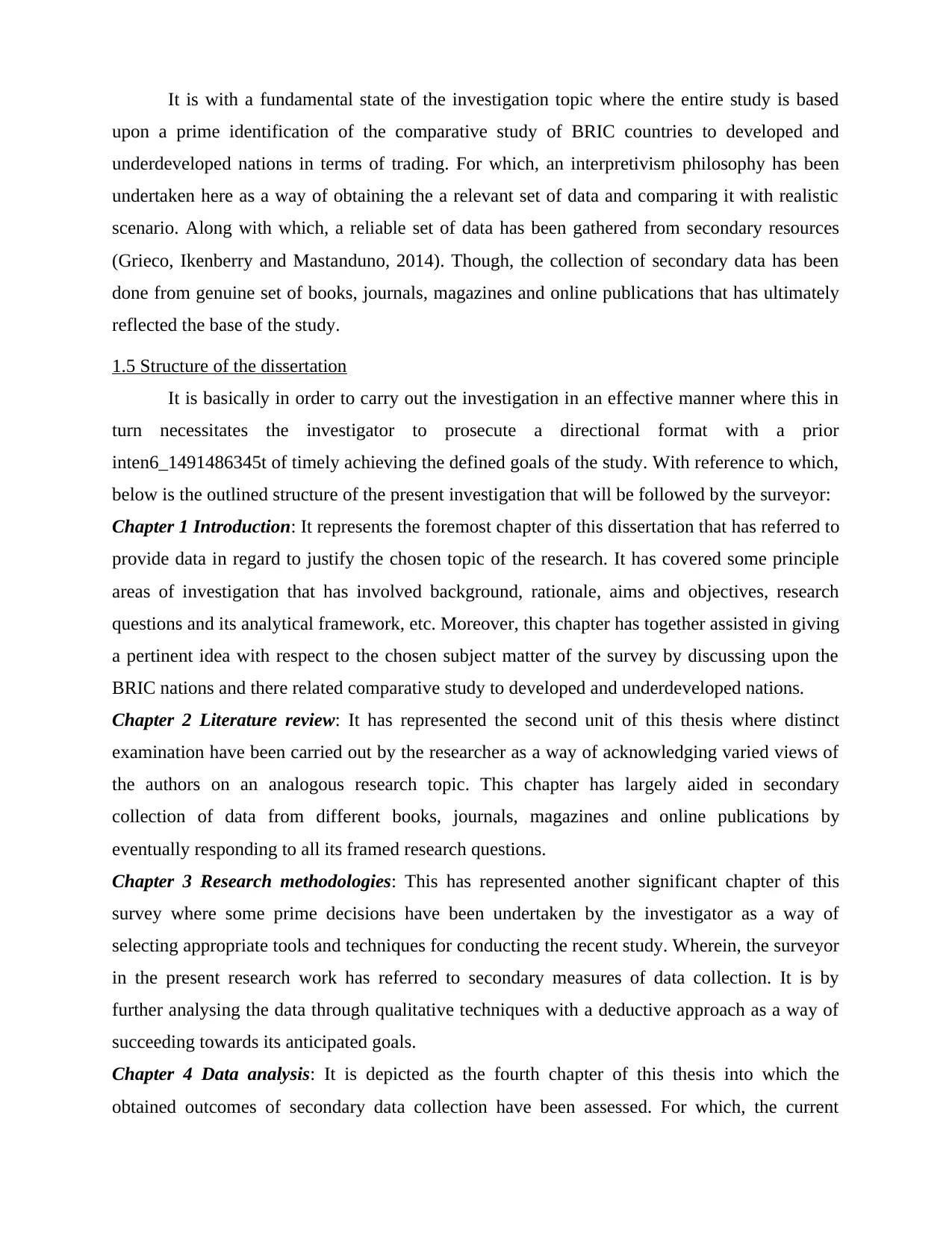
It is with a fundamental state of the investigation topic where the entire study is based
upon a prime identification of the comparative study of BRIC countries to developed and
underdeveloped nations in terms of trading. For which, an interpretivism philosophy has been
undertaken here as a way of obtaining the a relevant set of data and comparing it with realistic
scenario. Along with which, a reliable set of data has been gathered from secondary resources
(Grieco, Ikenberry and Mastanduno, 2014). Though, the collection of secondary data has been
done from genuine set of books, journals, magazines and online publications that has ultimately
reflected the base of the study.
1.5 Structure of the dissertation
It is basically in order to carry out the investigation in an effective manner where this in
turn necessitates the investigator to prosecute a directional format with a prior
inten6_1491486345t of timely achieving the defined goals of the study. With reference to which,
below is the outlined structure of the present investigation that will be followed by the surveyor:
Chapter 1 Introduction: It represents the foremost chapter of this dissertation that has referred to
provide data in regard to justify the chosen topic of the research. It has covered some principle
areas of investigation that has involved background, rationale, aims and objectives, research
questions and its analytical framework, etc. Moreover, this chapter has together assisted in giving
a pertinent idea with respect to the chosen subject matter of the survey by discussing upon the
BRIC nations and there related comparative study to developed and underdeveloped nations.
Chapter 2 Literature review: It has represented the second unit of this thesis where distinct
examination have been carried out by the researcher as a way of acknowledging varied views of
the authors on an analogous research topic. This chapter has largely aided in secondary
collection of data from different books, journals, magazines and online publications by
eventually responding to all its framed research questions.
Chapter 3 Research methodologies: This has represented another significant chapter of this
survey where some prime decisions have been undertaken by the investigator as a way of
selecting appropriate tools and techniques for conducting the recent study. Wherein, the surveyor
in the present research work has referred to secondary measures of data collection. It is by
further analysing the data through qualitative techniques with a deductive approach as a way of
succeeding towards its anticipated goals.
Chapter 4 Data analysis: It is depicted as the fourth chapter of this thesis into which the
obtained outcomes of secondary data collection have been assessed. For which, the current
upon a prime identification of the comparative study of BRIC countries to developed and
underdeveloped nations in terms of trading. For which, an interpretivism philosophy has been
undertaken here as a way of obtaining the a relevant set of data and comparing it with realistic
scenario. Along with which, a reliable set of data has been gathered from secondary resources
(Grieco, Ikenberry and Mastanduno, 2014). Though, the collection of secondary data has been
done from genuine set of books, journals, magazines and online publications that has ultimately
reflected the base of the study.
1.5 Structure of the dissertation
It is basically in order to carry out the investigation in an effective manner where this in
turn necessitates the investigator to prosecute a directional format with a prior
inten6_1491486345t of timely achieving the defined goals of the study. With reference to which,
below is the outlined structure of the present investigation that will be followed by the surveyor:
Chapter 1 Introduction: It represents the foremost chapter of this dissertation that has referred to
provide data in regard to justify the chosen topic of the research. It has covered some principle
areas of investigation that has involved background, rationale, aims and objectives, research
questions and its analytical framework, etc. Moreover, this chapter has together assisted in giving
a pertinent idea with respect to the chosen subject matter of the survey by discussing upon the
BRIC nations and there related comparative study to developed and underdeveloped nations.
Chapter 2 Literature review: It has represented the second unit of this thesis where distinct
examination have been carried out by the researcher as a way of acknowledging varied views of
the authors on an analogous research topic. This chapter has largely aided in secondary
collection of data from different books, journals, magazines and online publications by
eventually responding to all its framed research questions.
Chapter 3 Research methodologies: This has represented another significant chapter of this
survey where some prime decisions have been undertaken by the investigator as a way of
selecting appropriate tools and techniques for conducting the recent study. Wherein, the surveyor
in the present research work has referred to secondary measures of data collection. It is by
further analysing the data through qualitative techniques with a deductive approach as a way of
succeeding towards its anticipated goals.
Chapter 4 Data analysis: It is depicted as the fourth chapter of this thesis into which the
obtained outcomes of secondary data collection have been assessed. For which, the current
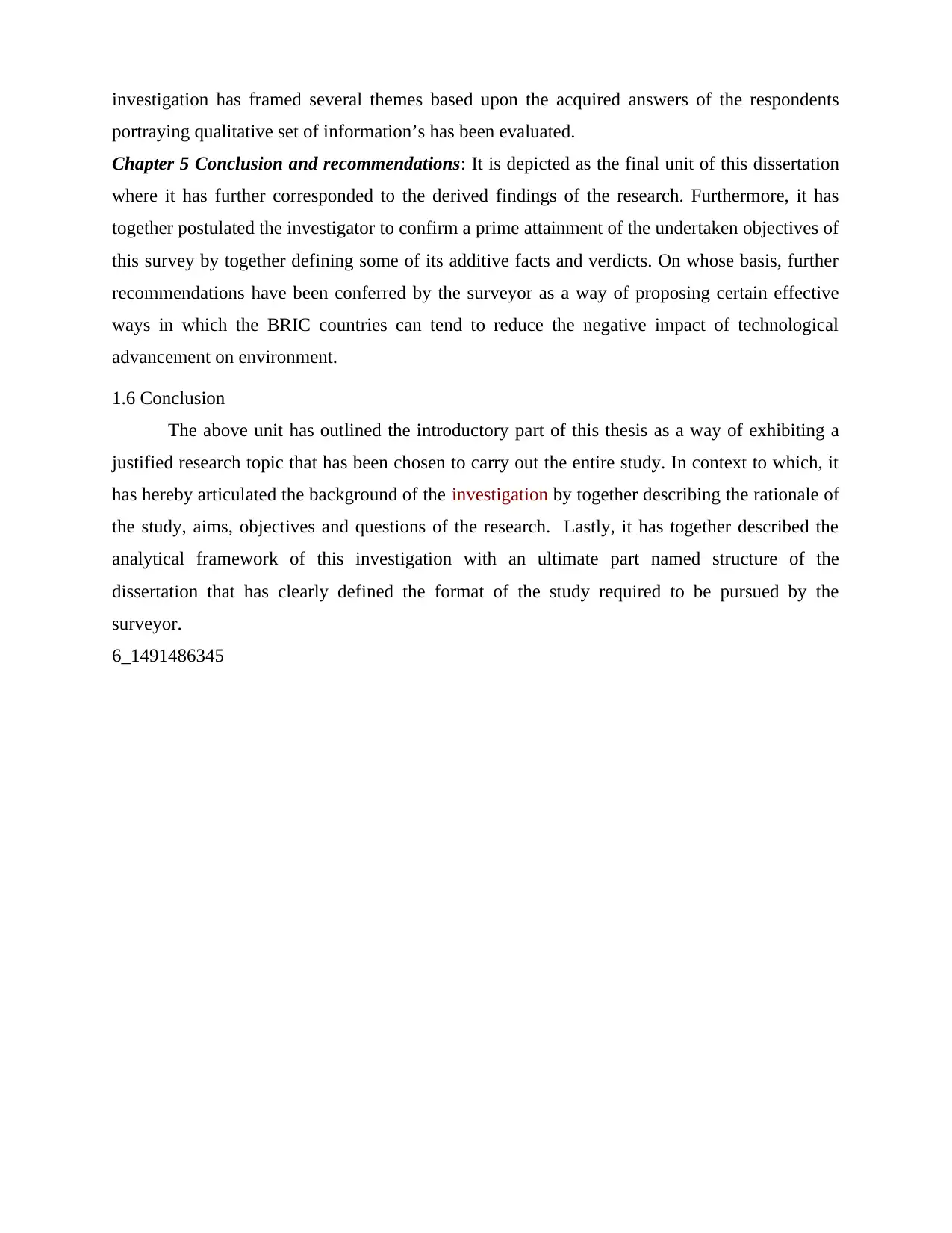
investigation has framed several themes based upon the acquired answers of the respondents
portraying qualitative set of information’s has been evaluated.
Chapter 5 Conclusion and recommendations: It is depicted as the final unit of this dissertation
where it has further corresponded to the derived findings of the research. Furthermore, it has
together postulated the investigator to confirm a prime attainment of the undertaken objectives of
this survey by together defining some of its additive facts and verdicts. On whose basis, further
recommendations have been conferred by the surveyor as a way of proposing certain effective
ways in which the BRIC countries can tend to reduce the negative impact of technological
advancement on environment.
1.6 Conclusion
The above unit has outlined the introductory part of this thesis as a way of exhibiting a
justified research topic that has been chosen to carry out the entire study. In context to which, it
has hereby articulated the background of the investigation by together describing the rationale of
the study, aims, objectives and questions of the research. Lastly, it has together described the
analytical framework of this investigation with an ultimate part named structure of the
dissertation that has clearly defined the format of the study required to be pursued by the
surveyor.
6_1491486345
portraying qualitative set of information’s has been evaluated.
Chapter 5 Conclusion and recommendations: It is depicted as the final unit of this dissertation
where it has further corresponded to the derived findings of the research. Furthermore, it has
together postulated the investigator to confirm a prime attainment of the undertaken objectives of
this survey by together defining some of its additive facts and verdicts. On whose basis, further
recommendations have been conferred by the surveyor as a way of proposing certain effective
ways in which the BRIC countries can tend to reduce the negative impact of technological
advancement on environment.
1.6 Conclusion
The above unit has outlined the introductory part of this thesis as a way of exhibiting a
justified research topic that has been chosen to carry out the entire study. In context to which, it
has hereby articulated the background of the investigation by together describing the rationale of
the study, aims, objectives and questions of the research. Lastly, it has together described the
analytical framework of this investigation with an ultimate part named structure of the
dissertation that has clearly defined the format of the study required to be pursued by the
surveyor.
6_1491486345
⊘ This is a preview!⊘
Do you want full access?
Subscribe today to unlock all pages.

Trusted by 1+ million students worldwide
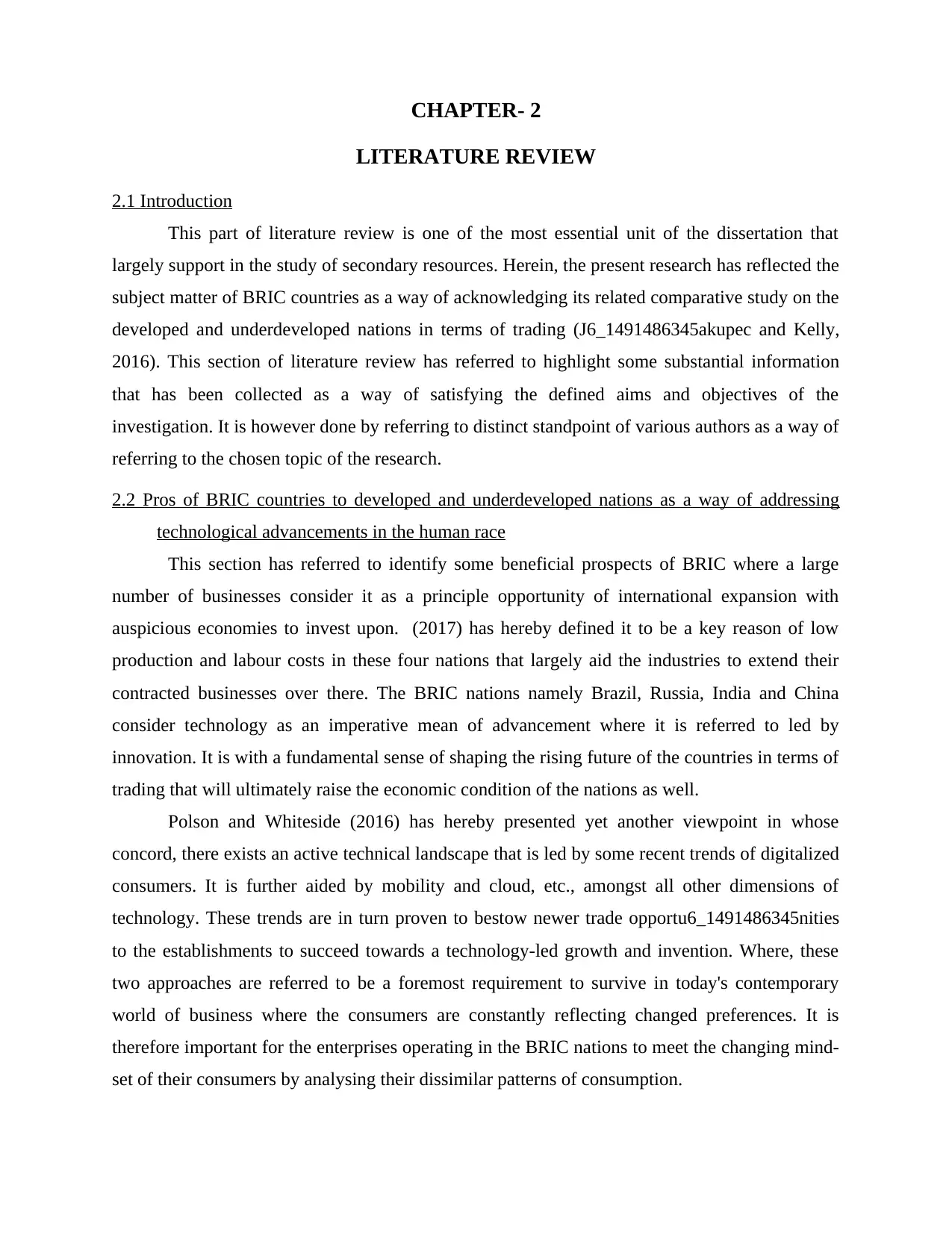
CHAPTER- 2
LITERATURE REVIEW
2.1 Introduction
This part of literature review is one of the most essential unit of the dissertation that
largely support in the study of secondary resources. Herein, the present research has reflected the
subject matter of BRIC countries as a way of acknowledging its related comparative study on the
developed and underdeveloped nations in terms of trading (J6_1491486345akupec and Kelly,
2016). This section of literature review has referred to highlight some substantial information
that has been collected as a way of satisfying the defined aims and objectives of the
investigation. It is however done by referring to distinct standpoint of various authors as a way of
referring to the chosen topic of the research.
2.2 Pros of BRIC countries to developed and underdeveloped nations as a way of addressing
technological advancements in the human race
This section has referred to identify some beneficial prospects of BRIC where a large
number of businesses consider it as a principle opportunity of international expansion with
auspicious economies to invest upon. (2017) has hereby defined it to be a key reason of low
production and labour costs in these four nations that largely aid the industries to extend their
contracted businesses over there. The BRIC nations namely Brazil, Russia, India and China
consider technology as an imperative mean of advancement where it is referred to led by
innovation. It is with a fundamental sense of shaping the rising future of the countries in terms of
trading that will ultimately raise the economic condition of the nations as well.
Polson and Whiteside (2016) has hereby presented yet another viewpoint in whose
concord, there exists an active technical landscape that is led by some recent trends of digitalized
consumers. It is further aided by mobility and cloud, etc., amongst all other dimensions of
technology. These trends are in turn proven to bestow newer trade opportu6_1491486345nities
to the establishments to succeed towards a technology-led growth and invention. Where, these
two approaches are referred to be a foremost requirement to survive in today's contemporary
world of business where the consumers are constantly reflecting changed preferences. It is
therefore important for the enterprises operating in the BRIC nations to meet the changing mind-
set of their consumers by analysing their dissimilar patterns of consumption.
LITERATURE REVIEW
2.1 Introduction
This part of literature review is one of the most essential unit of the dissertation that
largely support in the study of secondary resources. Herein, the present research has reflected the
subject matter of BRIC countries as a way of acknowledging its related comparative study on the
developed and underdeveloped nations in terms of trading (J6_1491486345akupec and Kelly,
2016). This section of literature review has referred to highlight some substantial information
that has been collected as a way of satisfying the defined aims and objectives of the
investigation. It is however done by referring to distinct standpoint of various authors as a way of
referring to the chosen topic of the research.
2.2 Pros of BRIC countries to developed and underdeveloped nations as a way of addressing
technological advancements in the human race
This section has referred to identify some beneficial prospects of BRIC where a large
number of businesses consider it as a principle opportunity of international expansion with
auspicious economies to invest upon. (2017) has hereby defined it to be a key reason of low
production and labour costs in these four nations that largely aid the industries to extend their
contracted businesses over there. The BRIC nations namely Brazil, Russia, India and China
consider technology as an imperative mean of advancement where it is referred to led by
innovation. It is with a fundamental sense of shaping the rising future of the countries in terms of
trading that will ultimately raise the economic condition of the nations as well.
Polson and Whiteside (2016) has hereby presented yet another viewpoint in whose
concord, there exists an active technical landscape that is led by some recent trends of digitalized
consumers. It is further aided by mobility and cloud, etc., amongst all other dimensions of
technology. These trends are in turn proven to bestow newer trade opportu6_1491486345nities
to the establishments to succeed towards a technology-led growth and invention. Where, these
two approaches are referred to be a foremost requirement to survive in today's contemporary
world of business where the consumers are constantly reflecting changed preferences. It is
therefore important for the enterprises operating in the BRIC nations to meet the changing mind-
set of their consumers by analysing their dissimilar patterns of consumption.
Paraphrase This Document
Need a fresh take? Get an instant paraphrase of this document with our AI Paraphraser
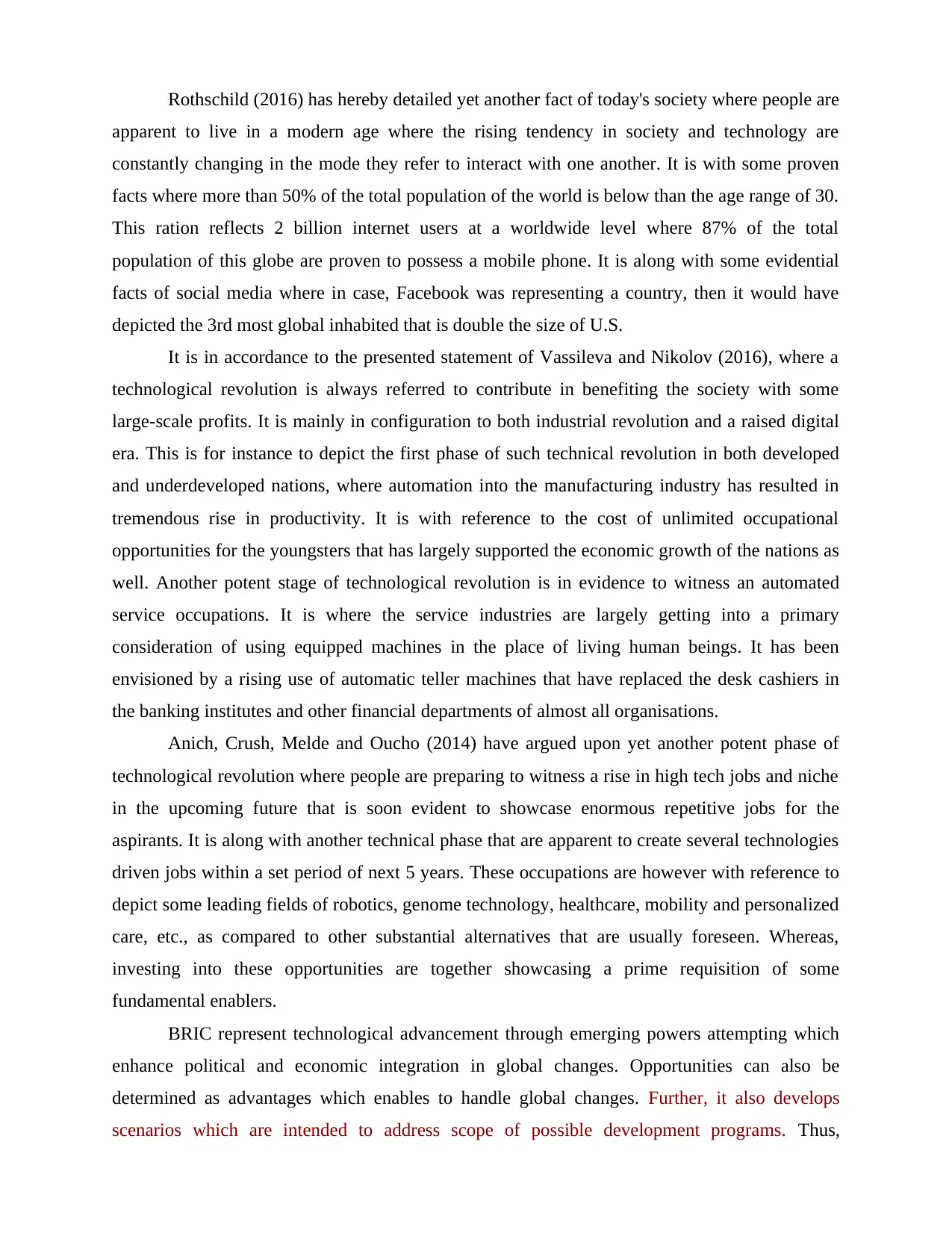
Rothschild (2016) has hereby detailed yet another fact of today's society where people are
apparent to live in a modern age where the rising tendency in society and technology are
constantly changing in the mode they refer to interact with one another. It is with some proven
facts where more than 50% of the total population of the world is below than the age range of 30.
This ration reflects 2 billion internet users at a worldwide level where 87% of the total
population of this globe are proven to possess a mobile phone. It is along with some evidential
facts of social media where in case, Facebook was representing a country, then it would have
depicted the 3rd most global inhabited that is double the size of U.S.
It is in accordance to the presented statement of Vassileva and Nikolov (2016), where a
technological revolution is always referred to contribute in benefiting the society with some
large-scale profits. It is mainly in configuration to both industrial revolution and a raised digital
era. This is for instance to depict the first phase of such technical revolution in both developed
and underdeveloped nations, where automation into the manufacturing industry has resulted in
tremendous rise in productivity. It is with reference to the cost of unlimited occupational
opportunities for the youngsters that has largely supported the economic growth of the nations as
well. Another potent stage of technological revolution is in evidence to witness an automated
service occupations. It is where the service industries are largely getting into a primary
consideration of using equipped machines in the place of living human beings. It has been
envisioned by a rising use of automatic teller machines that have replaced the desk cashiers in
the banking institutes and other financial departments of almost all organisations.
Anich, Crush, Melde and Oucho (2014) have argued upon yet another potent phase of
technological revolution where people are preparing to witness a rise in high tech jobs and niche
in the upcoming future that is soon evident to showcase enormous repetitive jobs for the
aspirants. It is along with another technical phase that are apparent to create several technologies
driven jobs within a set period of next 5 years. These occupations are however with reference to
depict some leading fields of robotics, genome technology, healthcare, mobility and personalized
care, etc., as compared to other substantial alternatives that are usually foreseen. Whereas,
investing into these opportunities are together showcasing a prime requisition of some
fundamental enablers.
BRIC represent technological advancement through emerging powers attempting which
enhance political and economic integration in global changes. Opportunities can also be
determined as advantages which enables to handle global changes. Further, it also develops
scenarios which are intended to address scope of possible development programs. Thus,
apparent to live in a modern age where the rising tendency in society and technology are
constantly changing in the mode they refer to interact with one another. It is with some proven
facts where more than 50% of the total population of the world is below than the age range of 30.
This ration reflects 2 billion internet users at a worldwide level where 87% of the total
population of this globe are proven to possess a mobile phone. It is along with some evidential
facts of social media where in case, Facebook was representing a country, then it would have
depicted the 3rd most global inhabited that is double the size of U.S.
It is in accordance to the presented statement of Vassileva and Nikolov (2016), where a
technological revolution is always referred to contribute in benefiting the society with some
large-scale profits. It is mainly in configuration to both industrial revolution and a raised digital
era. This is for instance to depict the first phase of such technical revolution in both developed
and underdeveloped nations, where automation into the manufacturing industry has resulted in
tremendous rise in productivity. It is with reference to the cost of unlimited occupational
opportunities for the youngsters that has largely supported the economic growth of the nations as
well. Another potent stage of technological revolution is in evidence to witness an automated
service occupations. It is where the service industries are largely getting into a primary
consideration of using equipped machines in the place of living human beings. It has been
envisioned by a rising use of automatic teller machines that have replaced the desk cashiers in
the banking institutes and other financial departments of almost all organisations.
Anich, Crush, Melde and Oucho (2014) have argued upon yet another potent phase of
technological revolution where people are preparing to witness a rise in high tech jobs and niche
in the upcoming future that is soon evident to showcase enormous repetitive jobs for the
aspirants. It is along with another technical phase that are apparent to create several technologies
driven jobs within a set period of next 5 years. These occupations are however with reference to
depict some leading fields of robotics, genome technology, healthcare, mobility and personalized
care, etc., as compared to other substantial alternatives that are usually foreseen. Whereas,
investing into these opportunities are together showcasing a prime requisition of some
fundamental enablers.
BRIC represent technological advancement through emerging powers attempting which
enhance political and economic integration in global changes. Opportunities can also be
determined as advantages which enables to handle global changes. Further, it also develops
scenarios which are intended to address scope of possible development programs. Thus,
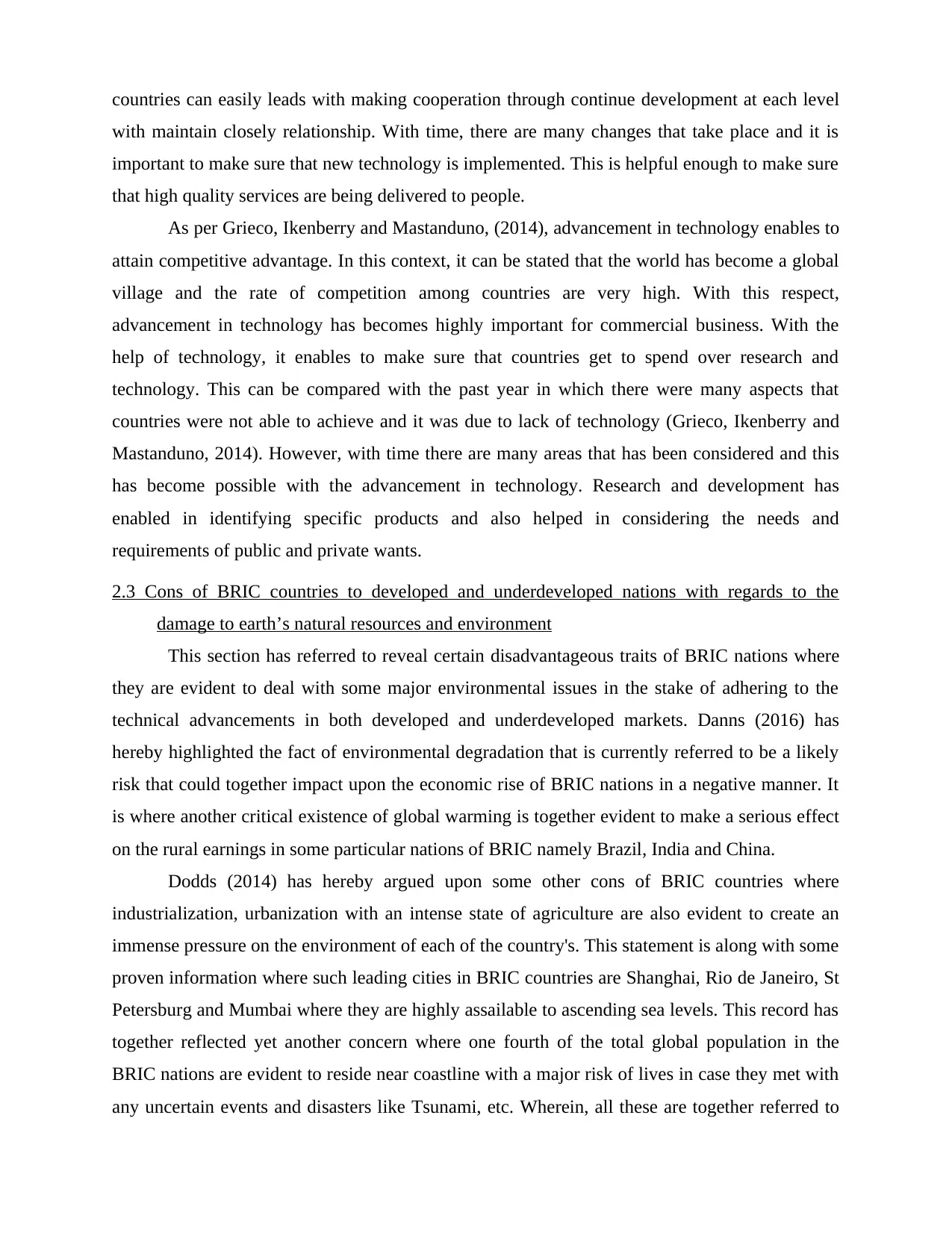
countries can easily leads with making cooperation through continue development at each level
with maintain closely relationship. With time, there are many changes that take place and it is
important to make sure that new technology is implemented. This is helpful enough to make sure
that high quality services are being delivered to people.
As per Grieco, Ikenberry and Mastanduno, (2014), advancement in technology enables to
attain competitive advantage. In this context, it can be stated that the world has become a global
village and the rate of competition among countries are very high. With this respect,
advancement in technology has becomes highly important for commercial business. With the
help of technology, it enables to make sure that countries get to spend over research and
technology. This can be compared with the past year in which there were many aspects that
countries were not able to achieve and it was due to lack of technology (Grieco, Ikenberry and
Mastanduno, 2014). However, with time there are many areas that has been considered and this
has become possible with the advancement in technology. Research and development has
enabled in identifying specific products and also helped in considering the needs and
requirements of public and private wants.
2.3 Cons of BRIC countries to developed and underdeveloped nations with regards to the
damage to earth’s natural resources and environment
This section has referred to reveal certain disadvantageous traits of BRIC nations where
they are evident to deal with some major environmental issues in the stake of adhering to the
technical advancements in both developed and underdeveloped markets. Danns (2016) has
hereby highlighted the fact of environmental degradation that is currently referred to be a likely
risk that could together impact upon the economic rise of BRIC nations in a negative manner. It
is where another critical existence of global warming is together evident to make a serious effect
on the rural earnings in some particular nations of BRIC namely Brazil, India and China.
Dodds (2014) has hereby argued upon some other cons of BRIC countries where
industrialization, urbanization with an intense state of agriculture are also evident to create an
immense pressure on the environment of each of the country's. This statement is along with some
proven information where such leading cities in BRIC countries are Shanghai, Rio de Janeiro, St
Petersburg and Mumbai where they are highly assailable to ascending sea levels. This record has
together reflected yet another concern where one fourth of the total global population in the
BRIC nations are evident to reside near coastline with a major risk of lives in case they met with
any uncertain events and disasters like Tsunami, etc. Wherein, all these are together referred to
with maintain closely relationship. With time, there are many changes that take place and it is
important to make sure that new technology is implemented. This is helpful enough to make sure
that high quality services are being delivered to people.
As per Grieco, Ikenberry and Mastanduno, (2014), advancement in technology enables to
attain competitive advantage. In this context, it can be stated that the world has become a global
village and the rate of competition among countries are very high. With this respect,
advancement in technology has becomes highly important for commercial business. With the
help of technology, it enables to make sure that countries get to spend over research and
technology. This can be compared with the past year in which there were many aspects that
countries were not able to achieve and it was due to lack of technology (Grieco, Ikenberry and
Mastanduno, 2014). However, with time there are many areas that has been considered and this
has become possible with the advancement in technology. Research and development has
enabled in identifying specific products and also helped in considering the needs and
requirements of public and private wants.
2.3 Cons of BRIC countries to developed and underdeveloped nations with regards to the
damage to earth’s natural resources and environment
This section has referred to reveal certain disadvantageous traits of BRIC nations where
they are evident to deal with some major environmental issues in the stake of adhering to the
technical advancements in both developed and underdeveloped markets. Danns (2016) has
hereby highlighted the fact of environmental degradation that is currently referred to be a likely
risk that could together impact upon the economic rise of BRIC nations in a negative manner. It
is where another critical existence of global warming is together evident to make a serious effect
on the rural earnings in some particular nations of BRIC namely Brazil, India and China.
Dodds (2014) has hereby argued upon some other cons of BRIC countries where
industrialization, urbanization with an intense state of agriculture are also evident to create an
immense pressure on the environment of each of the country's. This statement is along with some
proven information where such leading cities in BRIC countries are Shanghai, Rio de Janeiro, St
Petersburg and Mumbai where they are highly assailable to ascending sea levels. This record has
together reflected yet another concern where one fourth of the total global population in the
BRIC nations are evident to reside near coastline with a major risk of lives in case they met with
any uncertain events and disasters like Tsunami, etc. Wherein, all these are together referred to
⊘ This is a preview!⊘
Do you want full access?
Subscribe today to unlock all pages.

Trusted by 1+ million students worldwide
1 out of 44
Related Documents
Your All-in-One AI-Powered Toolkit for Academic Success.
+13062052269
info@desklib.com
Available 24*7 on WhatsApp / Email
![[object Object]](/_next/static/media/star-bottom.7253800d.svg)
Unlock your academic potential
Copyright © 2020–2025 A2Z Services. All Rights Reserved. Developed and managed by ZUCOL.





